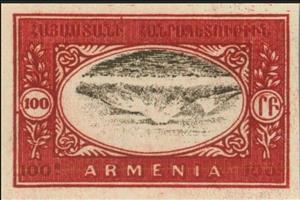Stamp: Mount Ararat (Armenia 1920)
Mount Ararat (Armenia 1920)
01 November (Armenia ) within release Parisian issue postage stamps of Armenia goes into circulation Stamp Mount Ararat face value 100 Armenian ruble
| Stamp Mount Ararat in catalogues | |
|---|---|
| Colnect codes: | Col: AM 1920-04 |
Stamp is horizontal format.
Rare. Printer Error: Image Center Reversed Not issued. Due to the lack of foreign currency, it was not possible to buy the entire circulation of stamps from the Parisian printing house Chaspo, which explains the sending to Armenia of only a part of the circulation, represented by stamps of the first five denominations - 1, 3, 5, 10 and 15 rubles. They were received in Erivan in the last days of November, by the time Armenia was declared a Soviet republic. The USSR People's Commissariat of Postal Service did not issue these stamps for public circulation. Subsequently, they were transferred to the Narkomfin of the USSR and, after overprinting them in the form of the state emblem of the USSR of Armenia, they were used as fiscal stamps. The part of the print run that remained in the Paris printing house was purchased in 1921 by foreign representatives of the former government of Armenia and transferred to philatelic shops for sale. The philatelic market also received test copies of stamps and a printing defect of the Paris edition.Also in the issue Parisian issue postage stamps of Armenia:
- Stamp - Country crest, eagle (Specimen) face value 1;
- Stamp - Country crest, eagle (Specimen) face value 3;
- Stamp - Country crest, eagle (Specimen) face value 5;
- Stamp - Country crest, eagle (Specimen) face value 10;
- Stamp - Country crest, eagle (Specimen) face value 15;
- Stamp - Mount Ararat face value 100;
- Stamp - Spinner face value 40;
- Stamp - Spinner face value 40;
- Stamp - Spinner face value 70;
Stamp Mount Ararat it reflects the thematic directions:
A landscape is the visible features of an area of land, its landforms and how they integrate with natural or man-made features. A landscape includes the physical elements of geophysically defined landforms such as (ice-capped) mountains, hills, water bodies such as rivers, lakes, ponds and the sea, living elements of land cover including indigenous vegetation, human elements including different forms of land use, buildings and structures, and transitory elements such as lighting and weather conditions. Combining both their physical origins and the cultural overlay of human presence, often created over millennia, landscapes reflect a living synthesis of people and place that is vital to local and national identity. The character of a landscape helps define the self-image of the people who inhabit it and a sense of place that differentiates one region from other regions. It is the dynamic backdrop to people’s lives. Landscape can be as varied as farmland, a landscape park, or wilderness. The earth has a vast range of landscapes, including the icy landscapes of polar regions, mountainous landscapes, vast arid desert landscapes, islands and coastal landscapes, densely forested or wooded landscapes including past boreal forests and tropical rainforests, and agricultural landscapes of temperate and tropical regions.
A volcano is a rupture in the crust of a planetary-mass object, such as Earth, that allows hot lava, volcanic ash, and gases to escape from a magma chamber below the surface. The process that forms volcanoes is called volcanism.


